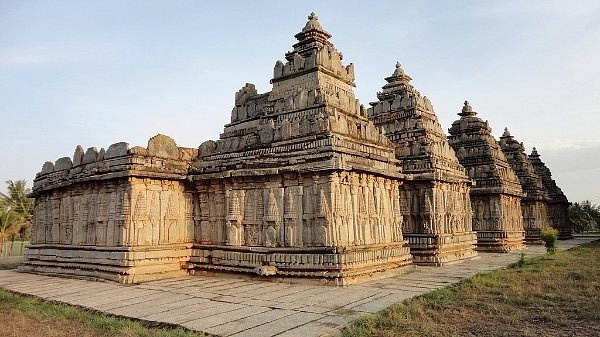Culture
Viral Revival—A Hashtag Does For Heritage What The Govt Should Be Doing
- #WalkToTemple, a Twitter hashtag that has people posting about Hindu temples has gone viral and is urging people to revisit and thereby revive the cultural heritage embodied by the temples.

Panchalingeshwara Temple, Mandya (HoysalaPhotos/Wiki Commons)
Temples have turned into the talk of the town, or rather tweet of the town, with a hashtag doing for temples and heritage what the authorities should but have not been doing.
The tweets have turned into massive hubs of discussion and more importantly decks of documentation. From images of temples, to hitherto unknown facts, the hashtag post has snowballed into a campaign to revisit and revive temples and their unparalleled grandeur and significance.
Some tweets have helped people unearth information including documents and artefacts tucked away in rusty iron cupboards of religiously populated temples, or hidden despite being visible in many a fondly forsaken temples.
A comment on this tweet, led to a thread that rakes out information from the scriptures engraved on a wall in the temple premise.
The tweet which initially just had an image of the temple turned into a mini documentary of sorts with the user giving information about the pillar inscriptions. Sourced out from the Epigraphica Indica Volume 21, the series of tweets, describes the reign of Virarajendra Chola who had won many a battles against the Chalukyas, and his sixth year of rule.
Quoting both the original inscriptions and an interpretation of the same by K V Subrahmanya Ayyar, the 140 character episodes narrates the tale of the ruler who was also known as Raja Kesarivarman conquering the region.
The chain of tweets gives various nuggets of information that give a glimpse into the times of the Chola ruler; of him propagating not just religion as prescribed by the vedas but also upholding liberty, the rituals performed to the deity and various activities that took place around temple rituals like the offerings made on a specific day, the Purvashada nakshatra in the month of Kartika when great offerings were made apart from a ceremonial bath to the idol.
A list of medicines to be stocked up in the hospitals of the King that had the names and the portions of various herbs and potions was also part of the inscriptions.
The inscriptions also provides details of various activities undertaken like the teaching of the Vedas, various facilities provided like student hostels and colleges and schemes for patient welfare.
All in all, one pillar, as the tweets testify, gives a deep insightful glimpse into how the ruler conducted his affairs, from efficient public administration to achieving social welfare.
Virtual activism in the form of hashtags shed light on aspects of heritage that have for long been ignored. A very strong perception of government apathy and antagonism towards what many see as immoral government control over thousands of religious institutions and structures have off late kicked off many such spontaneous phenomenons.
You can learn more about government control over temples from this article.
Introducing ElectionsHQ + 50 Ground Reports Project
The 2024 elections might seem easy to guess, but there are some important questions that shouldn't be missed.
Do freebies still sway voters? Do people prioritise infrastructure when voting? How will Punjab vote?
The answers to these questions provide great insights into where we, as a country, are headed in the years to come.
Swarajya is starting a project with an aim to do 50 solid ground stories and a smart commentary service on WhatsApp, a one-of-a-kind. We'd love your support during this election season.
Click below to contribute.
Latest